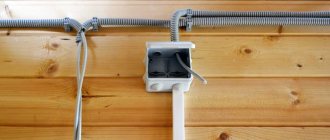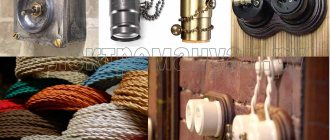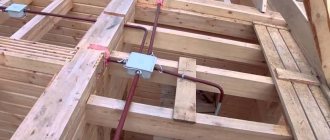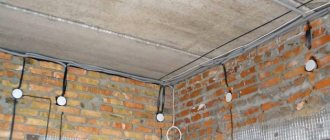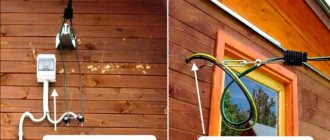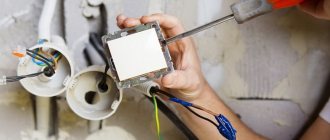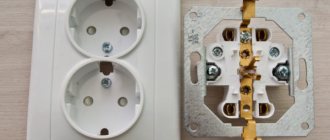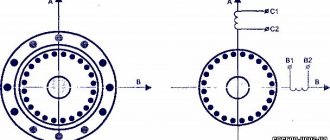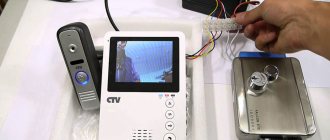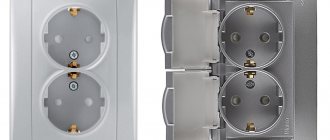Advantages of hidden wiring
When installing electrical wiring, many people choose a hidden installation option that does not spoil the interior design of the room.
The advantages of the method are obvious:
- There are no cable channels on the walls that are conspicuous and interfere with wallpapering the surface.
- Low risk of fire if the rules of the Electrical Installation Regulations are strictly followed during the hidden installation process.
- Ease of cable replacement if it is laid in a corrugated pipe.
- Low risk of mechanical damage due to installation of the product in concrete, metal products or a plaster layer.
- Safety for the residents of the house, because the wires are hidden from view and access to them is limited.
- There are no difficulties when performing finishing work, because the cable is located inside the finishing.
- There are no negative environmental impacts.
These reasons are enough to give preference to hidden wiring when arranging an electrical network in a wooden house.
Is it necessary to use corrugation when laying electrical cables and wires?
Is corrugation needed when laying cables or can electrical wiring be done without it? This simple question, although it has a fairly firm answer in the regulatory documentation, in particular in the PUE (Electrical Installation Rules), still causes a storm of fierce debate, which often misleads many people who are faced with replacing electrical wiring for the first time.
Moreover, this situation is fueled, it seems, by experienced electricians who receive a lot of money for their work and often, consciously or not, impose on their customers a method of laying cables that is not always justified.
What not to do, installation rules according to the PUE
Some “specialists” take on the installation of hidden wiring without sufficient knowledge and, accordingly, without taking into account the requirements of the PUE.
A common mistake that is made during work is installing a wire on a wooden surface and then covering it with wood trim.
The calculation is made on the strength of the wire and its insulation. Such connivance can lead to a fire, because processes occur in wooden recesses that are impossible to predict.
Over the years, cable products are negatively affected by temperature changes, dust, sudden changes in humidity or damage to insulating materials.
Under increased loads, when electrical equipment is turned on in all rooms (heaters, TV, multicooker and other equipment), a large current flows through the wires. As a result, the risk of a short circuit between two adjacent wires increases.
If there is no reflective non-flammable surface near the cable, a wooden building may catch fire even though it is impregnated with a special fire-fighting compound. It is almost impossible to stop the fire.
When choosing a hidden wiring option in a wooden house, you need to take into account the complexity of the process and the importance of meeting the requirements of GOST R (50571.1-2009) and PUE-7.
If you have no experience, it is better not to undertake installation. Invite qualified specialists who know the norms of the mentioned documents and follow the rules. But you don’t need to stay on the sidelines either. Knowledge of the requirements of the PUE and GOST R helps to control the hired electricians.
Project preparation
When creating a project for hidden wiring, attention is paid to the fire safety of a wooden house. This is true even to the detriment of appearance deterioration.
The hidden wiring diagram should have a minimum of turns. In this case, contact with wood must be avoided. The cable must be laid in copper and steel pipes. In a PVC corrugation or metal hose, installation under asbestos or plaster is allowed, but according to PEU 7 this is prohibited.
Before starting work, it is necessary to develop a project and coordinate it with the local power supply company (District Electric Networks).
PTS service employees develop technical conditions that apply when performing work. First, the total power of electrical appliances is calculated, and then a wiring diagram is developed.
Algorithm of actions when creating a project:
- Development of a technical plan for a wooden house. The diagram indicates the locations of electrical sockets, lamps, switches and electrical appliances with a separate supply.
- The type of cable is selected for each electrical point. If switches with two buttons and “triple” sockets (with a ground tap) are used, a cable with three cores is connected to them.
- The hidden wiring diagram for a wooden house shows the locations for installing junction boxes. To reduce their number, one distribution box is used for two rooms.
- The power consumption of each receiver is indicated. If the device is equipped with an electric motor, the parameter is indicated taking into account the starting current of the motor.
- Light bulbs, sconces and other lighting equipment are brought into one group, and consumers of higher power into the second. For reliability, both branches are connected to their own circuit breaker with an individual rated current.
- The distance from the installation site of hidden wiring to window and door frames, as well as electrical points to the ceiling or floor is indicated. This information is useful and helps protect the wiring from damage during repairs. Electrical cable turns are carried out only at right angles.
After preparing the circuit, the power consumed by electrical appliances is calculated if they are switched on simultaneously.
The rated load current of the input circuit breaker (the one located at the entrance to the room) is also calculated here.
Types of corrugated metal hoses
According to the molding method, the sleeve is divided into:
- Accordion type. It is completely sealed and holds its shape perfectly. It is usually made of stainless steel. It has two serious drawbacks: it is very expensive, and limited in flexibility. Curvature radius up to 20 sleeve diameters. If you bend it too much, it will simply burst. It is used to a limited extent, only for use in special conditions.
- Mass corrugation of turn type. The most common hose: used without restrictions both in industrial facilities and in residential premises. Complex configuration of joints: on the one hand, allows you to obtain a strong, unbreakable pipe, on the other hand, the hose can be bent to small radii. The only drawback is that the coil sleeve is not sealed. If moisture gets inside, it stays there for a long time.
- Corrugated with PVC coating. A polyvinyl chloride sleeve is located on top of the coil spring. Flexibility is reduced, but the pipe becomes completely sealed. The strength characteristics are unchanged: steel coils protect from mechanical stress. Fire safety is also not reduced: flame propagation does not occur in a closed environment.
According to the material of the main shell:
- Mostly, the coiled metal hose is made of galvanized steel. This is a relatively inexpensive material that resists corrosion for a long time. If the corrugation is static after installation, its service life is measured in decades.
- For suspended installation, when the hose can move, it is better to use stainless corrugation. The galvanic zinc coating on the coils does not wear off; the steel is more durable than galvanized steel: such a hose is almost eternal.
- A sealant is placed between the turns to provide tightness and reduce friction. This can be asbestos thread, cotton fabric, or polypropylene film. Of course, 100% tightness is not ensured, but the gasket protects against raindrops and local splashing.
Main and input cables, circuit breaker
When choosing a cable for hidden wiring in a wooden house, you need to take into account that it comes in two types - general (runs through the building) and input (to the machine). Let's look at the features for each option.
Basic wiring
The common cable is selected taking into account the loads in the room. When choosing, you need to know the maximum power (current) of the electrical equipment.
So, when using cable products with copper conductors for a cross section of 1.5 mm. sq. rated current is 19 A (for voltage 220 V and 4.1 kV). With a cross section of 2.5 sq. mm. copper wiring can withstand 27 A (5.9 kW).
In rare cases, it may be necessary to install a 4-square wire. In this case, the rated current is 38 A and the power is 8.3 kW. When choosing a cross-section, the rated power of each electrical appliance is taken into account.
The most popular type of cable for hidden wiring is NYM (its features are described above). The advantages are density, ease of installation and the presence of additional insulation, which is important for wooden houses.
The downside is the fear of strong bends, which can lead to damage. When connecting to sockets, cable products with three cores are used, which protects against electric shock. Grounding is also necessary when using powerful floodlights on site.
Application of flexible metal hoses
Flexible metal hoses provide reliable protection against mechanical damage and fire caused by a short circuit when laying:
- computer network;
- television cable;
- video surveillance systems;
- telephone cable;
- electrical wiring.
Various types of cables are laid in metal hoses in domestic and industrial environments.
In rooms with high humidity, products equipped with an additional protective PVC coating are used. The PVC shell prevents dust and water from entering, even with a directed jet. Therefore, the PVC-sheathed structure successfully protects the cable laid inside it:
- in a production area with high humidity levels;
- in the shower and bathroom;
- in the kitchen;
- in the sewer line.
Fastening is carried out using staples.
Selecting the product necessary for operation in certain conditions is not difficult, as is the fastener for the metal hose. The range is varied; for cable laying, you can choose a product with an internal passage diameter from six millimeters to one hundred. At the same time, in the range of 6-38 mm, the step in changing the diameter value is small.
Installation of hidden wiring in a wooden house
Installation of hidden wiring can begin after purchasing the equipment. For the work you will need cable products, AV, switches, sockets and light bulbs (chandeliers).
Distribution boxes are also purchased, which are installed in strict accordance with the specified diagram. When using finishing material, the wires are laid in an armored sleeve.
Subtleties and rules of installation
Unlike external wiring, where it is routed using ceramic rollers or brackets, in the hidden version the cable is hidden in the walls, cable duct or baseboard.
Installation is carried out carefully, because any damage to the insulation is fraught with a short circuit and possible fire. When an arc occurs, the surrounding air heats up to a temperature of 5000 degrees Celsius (this is enough to ignite wood).
The use of plastic corrugations or pipes for installation is unacceptable, because the products do not withstand long-term use and burn out when exposed to high temperatures.
Special wood impregnation does not protect against fire. By the way, steel corrugation does not protect from 5000 degrees, because its walls are small in thickness and are not designed for such heating.
That is why, when installing concealed installations, you need to select equipment that can withstand the high temperatures that occur during a short circuit. If the arc encounters an obstacle on its way, it quickly fades.
A better solution is to make hidden wiring in a wooden house using steel (copper) pipes or ducts. Their peculiarity is the convenience of cutting pieces and the ability to combine using different adapters, soldering or welding equipment.
To increase resistance to rust, the surface of the pipes must be coated with special paint.
You can use copper pipes, which are corrosion-resistant and easy to bend, but they come at a high price.
Rules for installing hidden wiring in a wooden house:
- The cable cannot touch the wooden surface. It is necessary to ensure that every centimeter of wiring is in special protection (a metal pipe or box).
- To install the tube into the wall, you need to make a groove, holes for fastening, or cut out a recess for wiring. To carry out such work will require skill and perseverance.
- Vertical channels are drilled when installing the crowns of the log house. Horizontal laying is done after the walls are installed.
- To pull the cable, a conductor (thin wire) is laid inside the pipe.
- Places of installation and transitions between rooms are insulated using additional elements (asbestos, alabaster, sleeves, metal boxes, etc.)
- When attaching hidden wiring, you need to take into account the number of lines. If several cables pass in one armored sleeve, this requires greater thickness. Hiding such a product in a wooden house is a difficult task.
When creating hidden wiring, you need to remember the importance of the RCD. The device provides instant shutdown when leakage currents occur. For reliability, there must be several devices (for each group).
Selecting a wiring route
When choosing a place to lay a route in a wooden house, you need to take into account the requirements of the PUE. Think through everything in such a way that the number of turns and bends is minimal.
If difficulties arise with pulling the cable due to the characteristics of the building or communications in the walls, junction boxes made of steel or copper are installed at problem points.
Installation of electrical wiring - step-by-step instructions
- To create a single contour, the tubes are connected to each other by bolting or welding.
- It is mandatory to use wires with non-flammable double (or more) insulation. These include such brands of wires as RKGM, VVGng LS, VVGng, NYM.
- The tubular circuit must be grounded to prevent breakdown or sparks.
- Access to distribution boxes must remain free.
- The electrical panel is installed in the corridor and attached to the wall on a non-flammable dielectric plate.
- All electrical appliances are grounded by connecting to the appropriate circuit.
- It is prohibited to use corrugated pipes and cable ducts for hidden wiring (PUE 7.1.38).
- Under no circumstances should cable ends be twisted together.
- When laying several parallel conductors, it is necessary to maintain a distance between them.
Electrical wiring test
After installing hidden wiring, it must be tested. This is especially important for wooden houses with a low level of fire resistance.
When checking, special instruments are used, and trained employees of electrical laboratories are invited to perform the work.
The range of events includes:
- visual inspection;
- grounding resistance measurement;
- AB check;
- phase-zero circuit test;
- checking protective devices;
- control of the chain between the ground electrode and the devices.
After completion of the work, a test report is drawn up and submitted. Carrying out such measures is mandatory, because they help to avoid accidents and prevent equipment breakdowns.
Useful tips
In conclusion, we present tips and results regarding the implementation of hidden wiring in wooden houses.
Basic points:
- For electrical wiring in a wooden house, it is better to use NYM - a cable with triple electrical insulation.
- The best circuit protection is provided by differential circuit breakers that protect the network from short circuits and leakage (RCD).
- Grounding junction boxes and metal pipes is a mandatory safety element.
- During installation, you need to take into account the shrinkage of the wooden house to avoid distortion and damage to the wires.
- The pipe connection must be as reliable as possible. Welding and soldering are used for joining.
- The best pipes are copper. Their advantages are resistance to corrosion and ease of bending.
- Plastic inserts are used at the ends of the pipes to protect the cable from damage.
- If lining or wooden wallpaper is used during installation, you can run pipes along the existing recesses.
- In a wooden house it is allowed to combine hidden and open wiring.
- Installation is done exclusively according to a scheme agreed upon with experts.
- The main attention is paid to fire protection, and only after that the aesthetic component.
- The optimal solution is to lay channels in existing recesses, window and door openings, under baseboards or ceiling cladding.
- When using corrugated pipes, it is necessary to cover the surface with plaster or asbestos gaskets.
- The pipes are joined together by threading or welding.
- Distribution boxes must be freely accessible.
Load distribution
To prevent overheating of the contacts and fire of the line, you should distribute the load as evenly as possible and distribute the wiring in the house. For the calculation, data obtained when the network was operating at design capacity for 20–30 minutes is used.
Group consumers according to the following principles:
- similar devices;
- summarized indicators;
- powerful devices with long operating time.
Place the installations along the lines, and upon completion of the calculations, select the number of directions, differential circuit breakers, RCDs, cross-section of cable cores and type of sockets for individual rooms.
Electrification of a wooden frame house is a complex process that requires compliance with numerous rules and recommendations prescribed in the PUE and joint venture. Without proper knowledge and experience, it is almost impossible to do it on your own. It is recommended to seek help from specialists, at least for consultation. Only competent installation of wiring and selection of high-quality materials guarantee the electrical and fire safety of the building.
